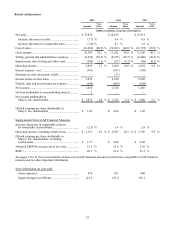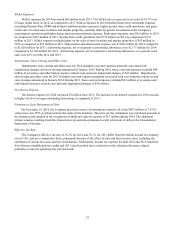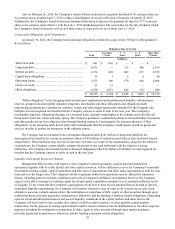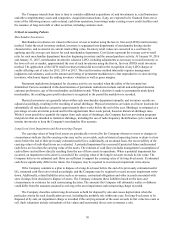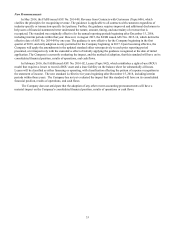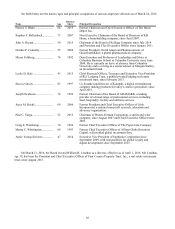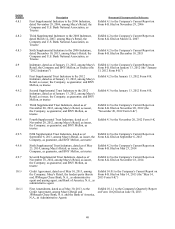Macy's 2015 Annual Report Download - page 36
Download and view the complete annual report
Please find page 36 of the 2015 Macy's annual report below. You can navigate through the pages in the report by either clicking on the pages listed below, or by using the keyword search tool below to find specific information within the annual report.31
Income Taxes
Income taxes are estimated based on the tax statutes, regulations and case law of the various jurisdictions in which
the Company operates. Deferred income tax assets and liabilities are recognized for the future tax consequences
attributable to differences between the financial statement carrying amounts of existing assets and liabilities and their
respective tax bases, and net operating loss and tax credit carryforwards. Deferred income tax assets and liabilities are
measured using enacted tax rates expected to apply to taxable income in the years in which those temporary differences are
expected to be recovered or settled. Deferred income tax assets are evaluated for recoverability based on all available
evidence, including past operating results, estimates of future taxable income, and the feasibility of tax planning strategies.
Deferred income tax assets are reduced by a valuation allowance when it is more likely than not that some portion of the
deferred income tax assets will not be realized.
Uncertain tax positions are recognized if the weight of available evidence indicates that it is more likely than not that
the tax position will be sustained on examination, including resolution of any related appeals or litigation processes, based
on the technical merits of the position. Uncertain tax positions meeting the more-likely-than-not recognition threshold are
then measured to determine the amount of benefit eligible for recognition in the financial statements. Each uncertain tax
position is measured at the largest amount of benefit that is more likely than not to be realized upon ultimate settlement.
Uncertain tax positions are evaluated and adjusted as appropriate, while taking into account the progress of audits of
various taxing jurisdictions. The Company does not anticipate that resolution of these matters will have a material impact
on the Company's consolidated financial position, results of operations or cash flows.
Significant judgment is required in evaluating the Company's uncertain tax positions, provision for income taxes, and
any valuation allowance recorded against deferred tax assets. Although the Company believes that its judgments are
reasonable, no assurance can be given that the final tax outcome of these matters will not be different from that which is
reflected in the Company's historical income provisions and accruals.
Self-Insurance Reserves
The Company, through its insurance subsidiary, is self-insured for workers' compensation and general liability claims
up to certain maximum liability amounts. Although the amounts accrued are actuarially determined by third parties based
on analysis of historical trends of losses, settlements, litigation costs and other factors, the amounts the Company will
ultimately disburse could differ from such accrued amounts.
Pension and Supplementary Retirement Plans
The Company has a funded defined benefit pension plan (the “Pension Plan”) and an unfunded defined benefit
supplementary retirement plan (the “SERP”). The Company accounts for these plans in accordance with ASC Topic 715,
“Compensation - Retirement Benefits.” Under ASC Topic 715, an employer recognizes the funded status of a defined
benefit postretirement plan as an asset or liability on the balance sheet and recognizes changes in that funded status in the
year in which the changes occur through comprehensive income. Additionally, pension expense is generally recognized on
an accrual basis over the average remaining lifetime of participants. The pension expense calculation is generally
independent of funding decisions or requirements.
The Pension Protection Act of 2006 provides the funding requirements for the Pension Plan which are different from
the employer's accounting for the plan as outlined in ASC Topic 715. No funding contributions were required, and the
Company made no funding contributions to the Pension Plan in 2015. As of the date of this report, the Company does not
anticipate making funding contributions to the Pension Plan in 2016. Management believes that, with respect to the
Company's current operations, cash on hand and funds from operations, together with available borrowing under its credit
facility and other capital resources, will be sufficient to cover the Company's Pension Plan cash requirements in both the
near term and also over the longer term.
At January 30, 2016, the Company had unrecognized actuarial losses of $1,451 million for the Pension Plan and
$261 million for the SERP. The unrecognized losses for the Pension Plan and the SERP will be recognized as a component
of pension expense in future years in accordance with ASC Topic 715, and is expected to impact 2016 Pension and SERP
net periodic benefit costs by approximately $39 million. The Company generally amortizes unrecognized gains and losses
on a straight-line basis over the average remaining lifetime of participants using the corridor approach. In addition,
approximately $135 million of net actuarial losses are also expected to be recognized in 2016 as part of a non-cash
settlement charge, resulting from an anticipated increase in lump sum distributions associated with store closings, a
voluntary separation program and organizational restructuring and small balance force outs, in addition to annual
distribution activity.



